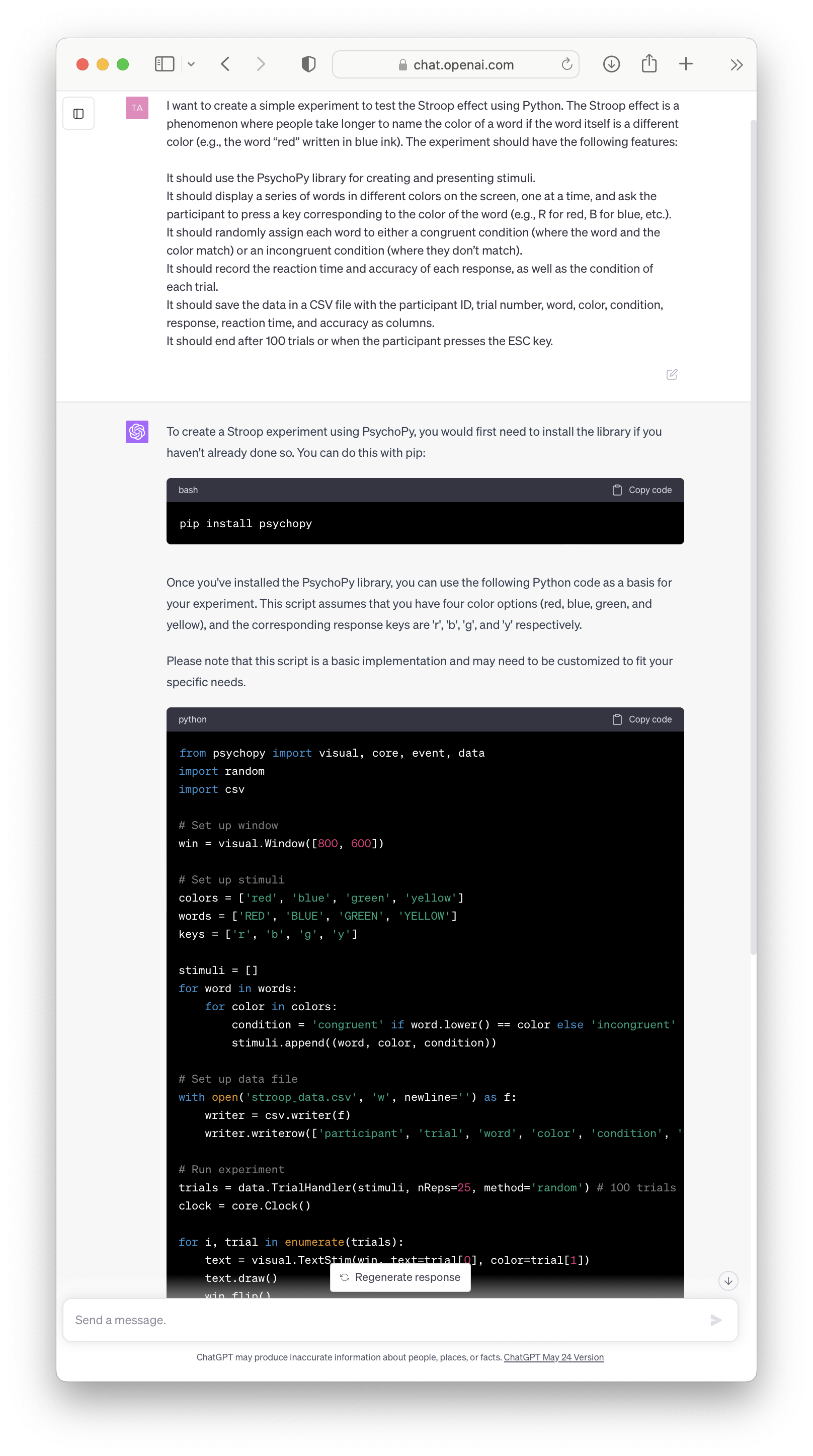22 Experiment Code
22.1 Program your experiments effectively.
The act of programming an experiment is akin to laying the foundation for a building. The entire structure of your research depends on this critical task. Having a well-written, efficient, and reliable experimental program guarantees that your experiment runs smoothly and captures accurate, reliable data.
Given the rising integration of artificial intelligence in research, tools like ChatGPT can be incredibly beneficial in facilitating your experiment programming. ChatGPT, designed with expertise in numerous programming languages, can guide you through the coding process, help troubleshoot issues, or even provide code snippets to meet your needs. It’s no surprise that advanced coding platforms, like GitHub Copilot, are integrating AI models like ChatGPT to enhance user coding experiences.
Notably, ChatGPT’s proficiency is proportional to the popularity of the programming language in use. More popular languages tend to provide a richer dataset for the model’s training, leading to better understanding and usage of such languages. As the model evolves, and as we move towards larger context windows, we’re ever closer to including entire coding documentation within our instructions. This means that, soon enough, we’ll be able to leverage ChatGPT for more efficient, versatile, and reliable programming support.
While AI can indeed bolster your experiment programming, it’s vital to approach this task with careful planning and precision. Remember, AI, while powerful, is not omniscient. ChatGPT cannot infer your requirements beyond what you provide. For example, it won’t automatically know that you want to randomise the positions of buttons on the screen or draw a sample from a larger set unless you specify these instructions.
Therefore, to maximise the benefits of using ChatGPT or similar tools, clarity and detail are paramount in your instructions. Avoid assumptions and explicitly state each step and requirement. Detail exactly how you envision your experiment: how it should look, how it should function, and how it should respond. Treat it as if you are communicating with someone entirely unfamiliar with your project.
In summary, programming your experiment doesn’t have to be a daunting task. With the assistance of AI tools like ChatGPT, you can create efficient, reliable, and robust experiment procedures. However, remember to approach this task with clarity and thoroughness. By detailing each step of your experiment, you can ensure that the resulting program aligns with your expectations and captures the data you need. Through meticulous planning and effective programming, you can lay a solid foundation for your experimental research.
22.1.1 Prompt
I want to create a simple experiment to test the Stroop effect using Python. The Stroop effect is a phenomenon where people take longer to name the colour of a word if the word itself is a different colour (e.g., the word "red" written in blue ink). The experiment should have the following features:
It should use the PsychoPy library for creating and presenting stimuli.It should display a series of words in different colours on the screen, one at a time, and ask the participant to press a key corresponding to the colour of the word (e.g., R for red, B for blue, etc.).It should randomly assign each word to either a congruent condition (where the word and the colour match) or an incongruent condition (where they don't match).It should record the reaction time and accuracy of each response, as well as the condition of each trial.It should save the data in a CSV file with the participant ID, trial number, word, colour, condition, response, reaction time, and accuracy as columns.It should end after 100 trials or when the participant presses the ESC key.
